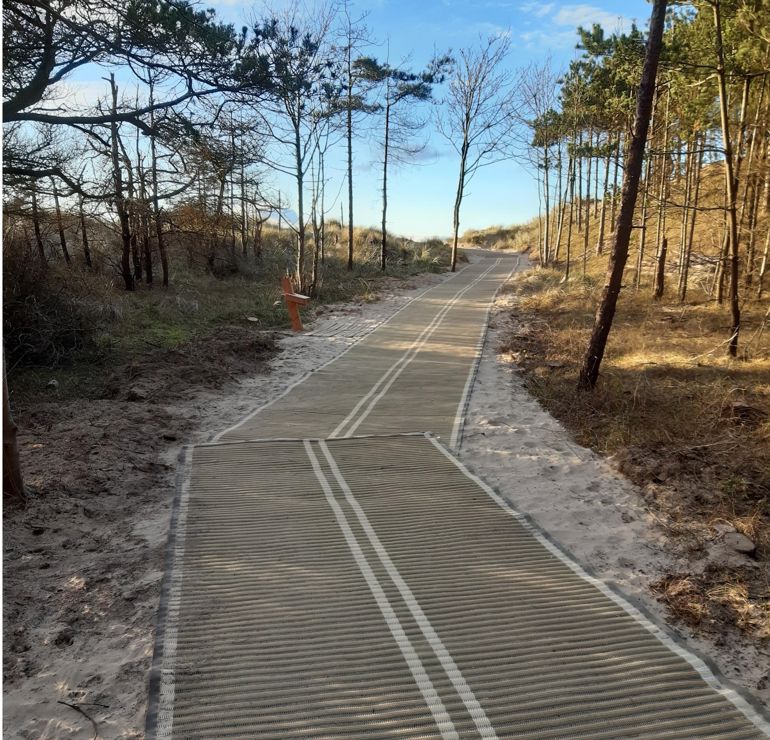Improving beach access while protecting dynamic dune systems

Natural Resources Wales’ Recreation Team Leader for North West Wales, John Taylor, explains the process of installing new accessible beach access at Anglesey’s Newborough National Nature Reserve and Forest.
The Dilemma
Newborough is of international biodiversity significance and home to some of Wales’ most precious habitats.
One of its most important conservation characteristics is the mobile dune systems which are crucial to the survival of some of Wales’ rarest plants and insects, such as the petalwort liverwort and the vernal mining bee.
Newborough is also Natural Resources Wales’ most popular site with around 500,000 visits a year from locals and tourists enjoying the site’s renowned natural beauty.
As part of our work under the Equality Act 2010, we strive to enable the ‘least restrictive access by all reasonable means’ while ensuring important conservation features, including the dynamic dune systems, are not impacted or constrained.
To find a suitable solution that meets both these statutory requirements has presented a significant challenge for the teams working at Newborough.
Previous Endeavours
In 2013, a timber boardwalk from the car park and over the coastal dune system to a beach viewing platform was constructed. Beach ladders were provided to enable access down to the sea as part of a larger EU funded project that provided improvements to the car park and other facilities.
While this protected the dune system from unnatural erosion due to footfall, it did not withstand the processes of coastal erosion which resulted in significant damage.

Since 2013 the frontal dune system has continued to erode and the boardwalk has been reduced in length. Due to the fact the remaining boardwalk now lies below the level of adjacent dunes, it acts as a manmade “blowout”, meaning sand accumulates on it.

An Adaptive Approach
Following extensive research and the monitoring of conditions on site, it became clear constructing rigid structures on the dynamic dune system was not a viable solution. It was also evident the boardwalk’s location was not suitable as it lies below the level of the adjacent dune and will therefore continue to accumulate sand.
Any suitable new access needed to be located where the current dune structure provided reasonably level access to the beach, without being significantly lower than adjacent dunes, while still retaining a frontal system to prevent a blowout forming. The route also required to be set at a 90 degree angle to prevailing winds for the same reason.
The structure itself needed to protect the access route from unnatural erosion from footfall, while having the ability to be repositioned, if required, due to natural dune processes.
By chance, recent dune movements provided a solution as sand had built up on a pre-existing service route from the beach to the residents’ road that was formed by contractors during the construction of the car park.
A sand permeable Mobi-Mat made from recycled plastic was chosen as the preference for the new beach access.

The Mobi-Mat, which was first trialled on site in July 2023 before being moved in January this year, helps prevent unnatural erosion from footfall and can be repositioned to accommodate any natural changes in the dune system.
If sand accumulates on the mat it can be shaken through rather than needing to be removed off it. The frontal dune structure is protected from erosion by using a sand ladder that can also be repositioned.
The Mobi Mat is usable by wheelchairs and we are working with Isle of Anglesey County Council to offer beach wheelchairs that will provide access down to the sea. The wheelchair must be booked in advance by calling 07816 110188.

By working with all our teams at Newborough we have ensured that all compliances and statutory requirements have been taken into consideration.
The existing boardwalk has now been closed to visitors and the main beach access to the Mobi-Mat is around 300 meters from it.
Is this a Permanent Solution?
Absolutely not. We fully anticipate the dune system and coastline will change to the extent that this solution will not be a permeant one.
Due to the fact the Mobi-Mat is reusable however, we feel this is a solution worth trying. Longer term, beach access will be part of our wider People Plan which is currently under development and will consider many other aspects of the visitor experience at Newborough.
